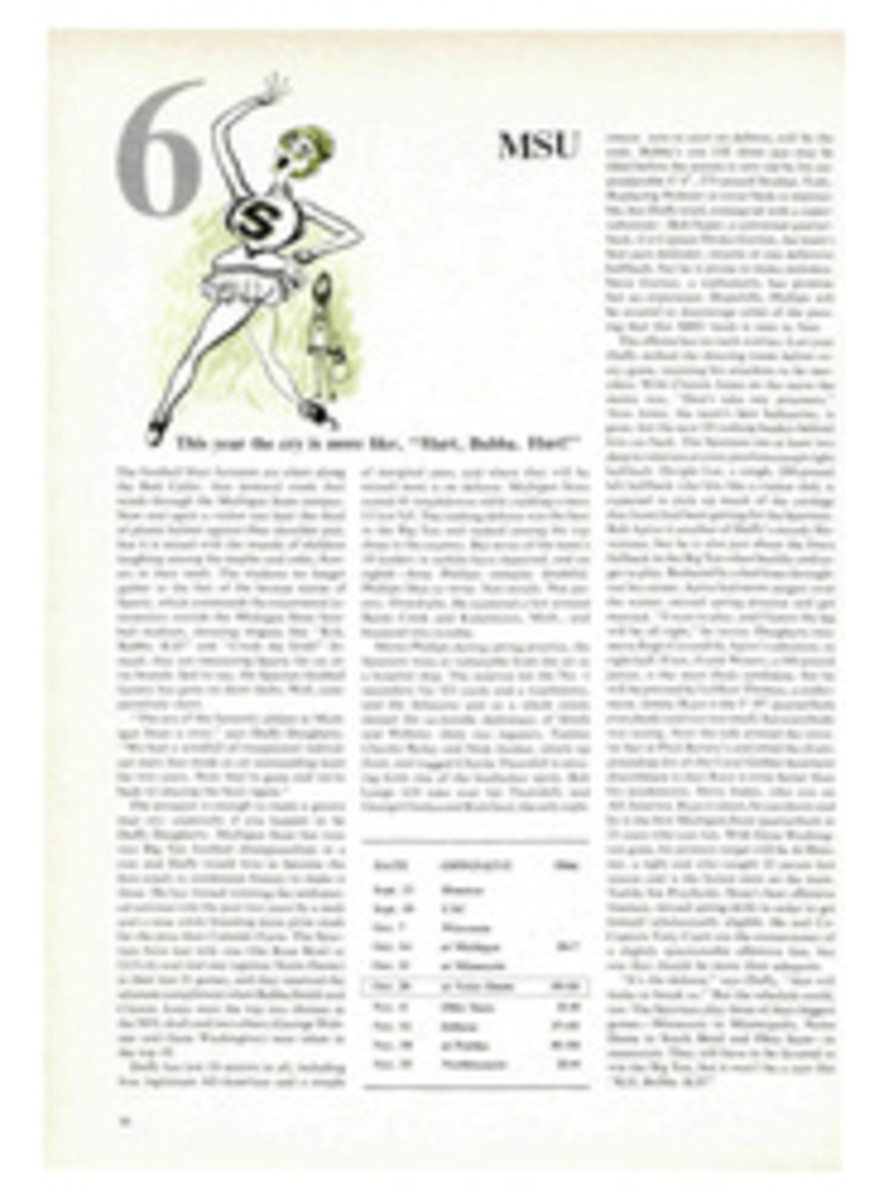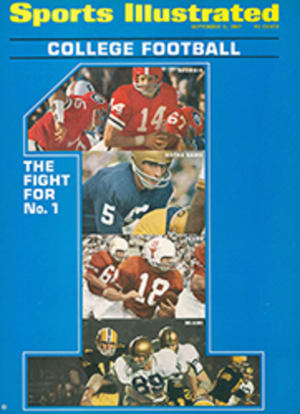
2 GEORGIA
After his first game as head coach at Georgia in the school's troubled year of 1964, Vince Dooley, who was only 32, was not so sure he was in the right business. Georgia had been crushed by Alabama 31-3, and though few coaches wind up singing victory marches after playing Alabama, Dooley took the defeat harder than most. It was, after all, his first game as a head coach anywhere. "I couldn't believe we'd been beaten that badly," he remembers. "During the bus ride back to Athens, the more I thought about it the more I doubted myself. I was sure I had let the players down. When I got home my wife, Barbara, was asleep, and I sat down on the edge of the bed and put my head in my hands. Then—all of a sudden—I just burst out laughing. Barbara thought I had cracked up for sure."
Since that night most of the cracking up has been done by teams trying to beat Georgia. Under Dooley, the Bulldogs have won 23, lost eight and tied one. They have shared an SEC championship with Alabama and have gone to two bowl games and won them both. Once more the best athletes in the state of Georgia are finding their way to Athens. There they play before bigger, louder crowds than ever—Sanford Stadium was double-decked this year to bring its capacity up to 59,000. They get fed tons of steak and enjoy color television in a plush new athletic dorm in which each room has a door that opens to the outside. There are no halls. "Most of the trouble in college dorms happens in the halls," explains Athletic Director Joel Eaves. If the weather is too bad, the players can even work out in Georgia's new $3 million Coliseum, which seats 12,000 for basketball and 15 in its steam baths. When Georgia surprised Alabama 18-17 two years ago, Dooley said how happy he was that the Bulldogs would not meet the Tide again until 1972; but now life is so good at Georgia that the team would like to get Alabama in a bowl somewhere—anywhere—this New Year's Day.
Georgia might get its wish, too, for if it loses a game this fall it will be an upset. Thirty-five lettermen are back from last year's team that lost only once, to Miami by a point. "I guess people will be picking us up there again," says Dooley sadly. "I suppose that's just the price of success."
It is difficult to pick Georgia anywhere else. Its entire starting backfield returns, including 225-pound Ronnie Jenkins, who may be the best fullback in the nation. Last year Jenkins blasted out 669 yards and turned the third-and-one play into a laugher. Tailback Kent Lawrence, who runs the 100 in 9.4, is the SEC's most dangerous man on sweeps, kickoff returns and punt returns. Rounding out the backfield is Hardy King, a versatile wingback who can block, run and catch a pass. There is also a new man to watch, Bruce Kemp, a red-shirt sophomore who had a fine spring. This combination of power and speed on the ground is the great strength of the Georgia team.
Once again the quarterback will be Kirby Moore (see cover), a confident leader who missed two games last season and still ran and passed for 1,003 yards. Dooley's primary concern is the possibility that Moore might miss a few games this season, too. "We put our quarterback in danger more than anybody else does," he says. "We run him. We expose him. Kirby is not a real strong boy and if he gets hurt I'll have to go with a sophomore for the first time since I've been here." Dooley makes this sound like a catastrophe, and in the case of a team attempting to maintain a ranking as high as Georgia's, it could be. But the man behind Moore is a good one. He is a home-town boy, Paul Gilbert, who is 6', 178, can throw deeper than Moore—in fact, most quarterbacks can—and is an accomplished runner in spite of his rather fragile dimensions.
The offensive line is not as deep as last year's but is almost as good. All-America Edgar Chandler, 222, will handle one tackle and the other will be either Don Hayes, 225, who was All-SEC at guard last year, or junior Dave Rholetter, a typical Georgia strong boy. Atlanta's Billy Payne may be the best tight end in Georgia's history. So the Bulldogs are rich in pop and crackle, but they do need some snap. "Centers? You can't recruit them," says Dooley. "You have to make them yourself." He is trying to make one out of Mike Lopatka, a 218-pound sophomore.
Graduations have hampered the defense a little. George Patton, a 230-pound All-America tackle, will be missed, as well as Lynn Hughes, the All-SEC safety man. But opponents say that 233-pound Bill Stanfill, a sophomore last year, actually bothered more runners than Patton, and Jake Scott, who returns after losing a season because of illness, may be better than Hughes. All-SEC Larry Kohn is back at one defensive end and Gary Adams will protect the other. Jiggy Smaha, 6'3", 240, is probably second only to Stanfill as an interior lineman, and if he does not wind up at center he will play alongside Tommy Lawhorne, a starter last year until he was injured. Terry Sellers, 195, is a fast back who led the Bulldogs in interceptions with five. It will be just as difficult—and painful—to score on Georgia as it was last year, when the team gave up less than nine points per game.
Rival coaches generally agree that Dooley is doing a recruiting job in the South that is second only to Bear Bryant's, and every year his teams seem to play more and more like the Tide. Recently one SEC coach—looking sour at the prospect of facing the Bulldogs this fall—said, "Georgia was just sitting there with all that tradition and spirit waiting for some energetic young guy to come along and make it a winner again. Dooley's the guy—and he's making the most of it."
If the Bulldogs don't stumble in Jackson against Mississippi, or slip beneath the Dome against Houston, they may meet Alabama in a bowl after all.
[originallink:10539246:43168]
ILLUSTRATION

